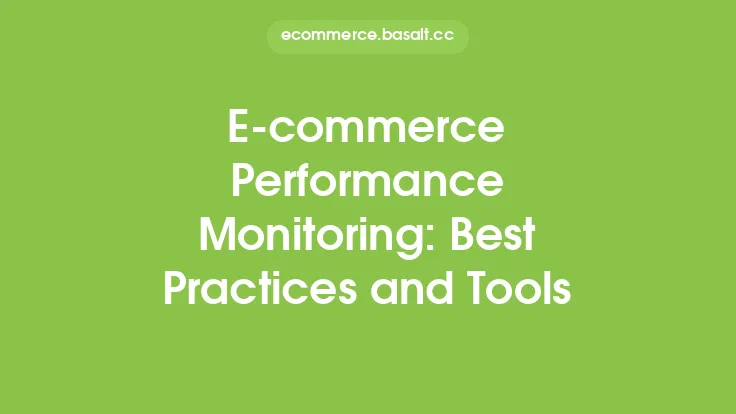In the world of e-commerce, understanding and measuring performance is crucial for success. With the ever-increasing competition in the online market, it's essential to track the right indicators to stay ahead of the game. E-commerce performance indicators provide valuable insights into the health and efficiency of an online store, helping businesses make informed decisions to drive growth and revenue. In this article, we'll delve into the key performance indicators (KPIs) that e-commerce businesses should track and why they're essential for success.
Introduction to E-commerce Performance Indicators
E-commerce performance indicators are metrics that measure the performance of an online store. These indicators can be categorized into different groups, including sales, marketing, customer service, and logistics. By tracking these indicators, businesses can identify areas of strength and weakness, set realistic goals, and develop strategies to improve overall performance. Some common e-commerce performance indicators include conversion rates, average order value, customer retention rates, and shipping times. Each of these indicators provides unique insights into the customer journey and helps businesses optimize their operations to meet customer needs.
Sales Performance Indicators
Sales performance indicators are critical for e-commerce businesses, as they directly impact revenue and growth. Some key sales performance indicators include:
- Conversion rates: The percentage of website visitors who complete a purchase.
- Average order value (AOV): The average amount spent by customers in a single transaction.
- Sales growth rate: The rate at which sales are increasing or decreasing over time.
- Product return rates: The percentage of products returned by customers.
- Gross margin: The difference between revenue and the cost of goods sold.
By tracking these indicators, businesses can identify opportunities to increase sales, optimize pricing strategies, and improve product offerings.
Marketing Performance Indicators
Marketing performance indicators help e-commerce businesses measure the effectiveness of their marketing campaigns and strategies. Some key marketing performance indicators include:
- Website traffic: The number of visitors to the website.
- Social media engagement: The level of engagement on social media platforms, including likes, shares, and comments.
- Email open rates: The percentage of email recipients who open marketing emails.
- Customer acquisition cost (CAC): The cost of acquiring a new customer.
- Return on ad spend (ROAS): The revenue generated by each dollar spent on advertising.
By tracking these indicators, businesses can refine their marketing strategies, allocate budget effectively, and improve brand awareness.
Customer Service Performance Indicators
Customer service performance indicators are essential for e-commerce businesses, as they directly impact customer satisfaction and loyalty. Some key customer service performance indicators include:
- Customer satisfaction (CSAT) scores: The level of satisfaction expressed by customers.
- Net promoter score (NPS): The likelihood of customers recommending the business to others.
- First response time: The time taken to respond to customer inquiries.
- Resolution rate: The percentage of customer issues resolved on the first contact.
- Customer retention rates: The percentage of customers who return to make repeat purchases.
By tracking these indicators, businesses can identify areas for improvement, develop strategies to enhance customer experience, and build strong relationships with customers.
Logistics and Fulfillment Performance Indicators
Logistics and fulfillment performance indicators are critical for e-commerce businesses, as they directly impact the customer experience and satisfaction. Some key logistics and fulfillment performance indicators include:
- Shipping times: The time taken to deliver products to customers.
- Order fulfillment rates: The percentage of orders fulfilled on time.
- Inventory turnover: The number of times inventory is sold and replaced within a given period.
- Return rates: The percentage of products returned by customers.
- Supply chain visibility: The ability to track products throughout the supply chain.
By tracking these indicators, businesses can optimize their logistics and fulfillment operations, reduce costs, and improve customer satisfaction.
Why Tracking E-commerce Performance Indicators is Important
Tracking e-commerce performance indicators is essential for businesses to make informed decisions, drive growth, and stay competitive. By monitoring these indicators, businesses can:
- Identify areas of strength and weakness
- Set realistic goals and develop strategies to achieve them
- Optimize operations to improve efficiency and reduce costs
- Enhance customer experience and build strong relationships
- Stay ahead of the competition and adapt to changing market trends
In conclusion, e-commerce performance indicators provide valuable insights into the health and efficiency of an online store. By tracking these indicators, businesses can make informed decisions, drive growth, and stay competitive in the ever-evolving world of e-commerce. Whether it's sales, marketing, customer service, or logistics, each indicator plays a critical role in helping businesses succeed and thrive in the online market.





